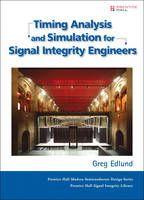
Timing Analysis and Simulation for Signal Integrity Engineers
Prentice Hall (Verlag)
9780132365048 (ISBN)
- Titel ist leider vergriffen;
keine Neuauflage - Artikel merken
Writing from the perspective of a practicing SI engineer and team lead, Greg Edlund of IBM presents deep knowledge and quantitative techniques for making better decisions about digital interface design. Edlund shares his insights into how and why digital interfaces fail, revealing how fundamental sources of pathological effects can combine to create fault conditions. You won’t just learn Edlund’s expert techniques for avoiding failures: you’ll learn how to develop the right approach for your own projects and environment.
Coverage includes
• Systematically ensure that interfaces will operate with positive timing margin over the product’s lifetime–without incurring excess cost
• Understand essential chip-to-chip timing concepts in the context of signal integrity
• Collect the right information upfront, so you can analyze new designs more effectively
• Review the circuits that store information in CMOS state machines–and how they fail
• Learn how to time common-clock, source synchronous, and high-speed serial transfers
• Thoroughly understand how interconnect electrical characteristics affect timing: propagation delay, impedance profile, crosstalk, resonances, and frequency-dependent loss
• Model 3D discontinuities using electromagnetic field solvers
• Walk through four case studies: coupled differential vias, land grid array connector, DDR2 memory data transfer, and PCI Express channel
• Appendices present a refresher on SPICE modeling and a high-level conceptual framework for electromagnetic field behavior
Objective, realistic, and practical, this is the signal integrity resource engineers have been searching for.
Preface xiii
Acknowledgments xvi
About the Author xix
About the Cover xx
Chapter 1: Engineering Reliable Digital Interfaces 1
Chapter 2: Chip-to-Chip Timing 13
Chapter 3: Inside IO Circuits 39
Chapter 4: Modeling 3D Discontinuities 73
Chapter 5: Practical 3D Examples 101
Chapter 6: DDR2 Case Study 133
Chapter 7: PCI Express Case Study 175
Appendix A: A Short CMOS and SPICE Primer 209
Appendix B: A Stroll Through 3D Fields 219
Endnotes 233
Index 235
Greg Edlund’s career in signal integrity began in 1988 at Supercomputer Systems, Inc., where he simulated and measured timing characteristics of bipolar embedded RAMs used in the computer’s vector registers. Since then, he has participated in the development and testing of nine other high-performance computing platforms for Cray Research, Inc., Digital Equipment Corp., and IBM Corp. He has had the good fortune of learning from many talented engineers while focusing his attention on modeling, simulation, and measurement of IO circuits and interconnect components. A solid physical foundation and practical engineering experience combine to form a valuable perspective on optimizing performance, reliability, and cost.
Preface xiii
Acknowledgments xvi
About the Author xix
About the Cover xx
Chapter 1: Engineering Reliable Digital Interfaces 1
Chapter 2: Chip-to-Chip Timing 13
Chapter 3: Inside IO Circuits 39
Chapter 4: Modeling 3D Discontinuities 73
Chapter 5: Practical 3D Examples 101
Chapter 6: DDR2 Case Study 133
Chapter 7: PCI Express Case Study 175
Appendix A: A Short CMOS and SPICE Primer 209
Appendix B: A Stroll Through 3D Fields 219
Endnotes 233
Index 235
| Erscheint lt. Verlag | 1.11.2007 |
|---|---|
| Reihe/Serie | Prentice Hall Modern Semiconductor Design Series |
| Verlagsort | Upper Saddle River |
| Sprache | englisch |
| Maße | 242 x 181 mm |
| Gewicht | 658 g |
| Themenwelt | Technik ► Elektrotechnik / Energietechnik |
| ISBN-13 | 9780132365048 / 9780132365048 |
| Zustand | Neuware |
| Informationen gemäß Produktsicherheitsverordnung (GPSR) | |
| Haben Sie eine Frage zum Produkt? |
aus dem Bereich


